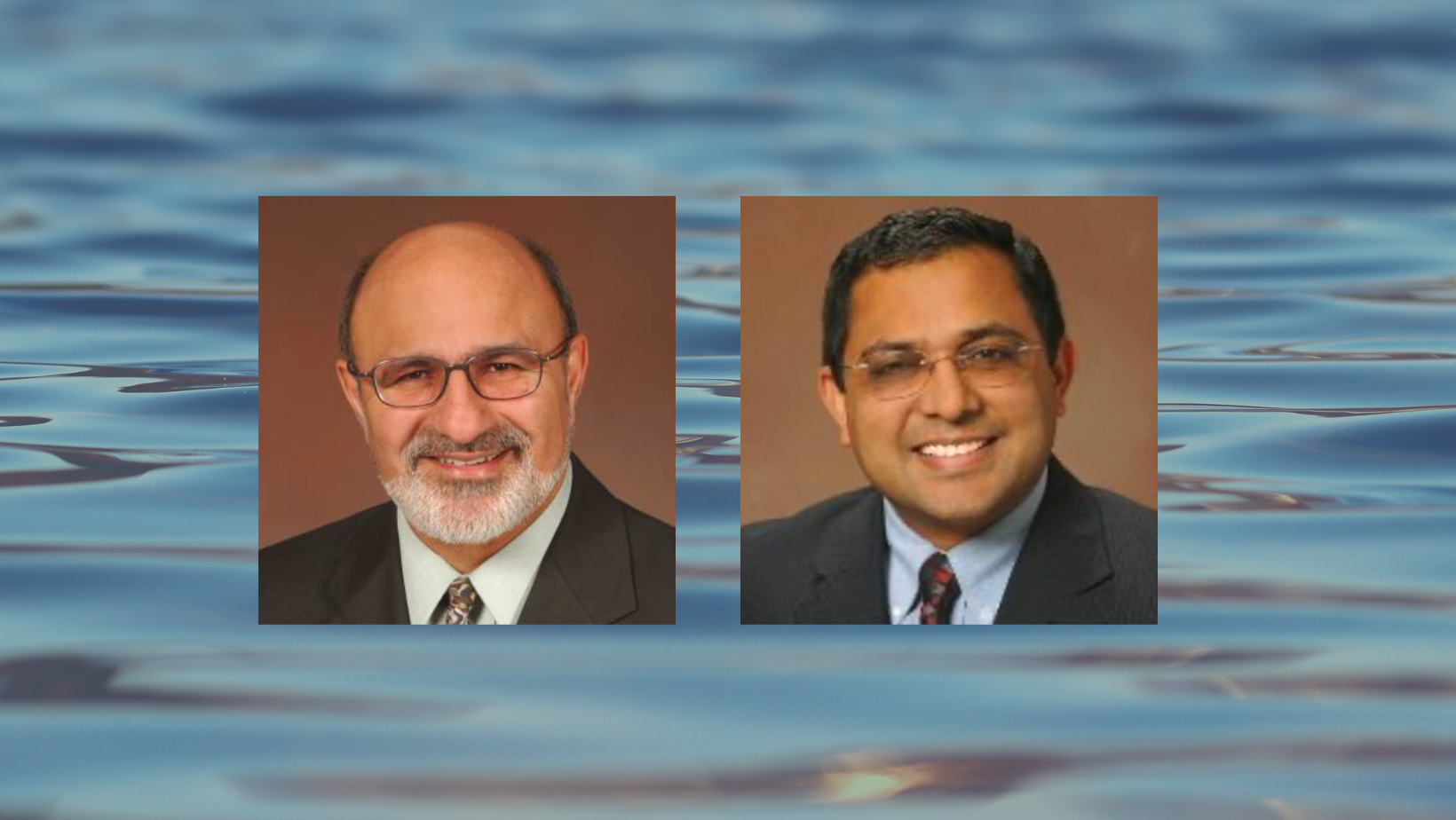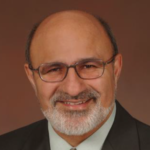
Our partnership with the California Department of Water Resources (DWR) is the bedrock for expanding our climate-modeling scenarios and tools to four additional watersheds in the San Joaquin Valley (SJV.) We sat down with Kamyar Guivetchi, Manager of the Division of Planning, and Ajay Goyal, Manager of the Statewide Infrastructure Investigations Branch, to talk about DWR’s role in the watershed expansion, what big-picture water management looks like now in California, and what it could, and hopefully should, look like in the future.
Thanks for chatting with us, both! So, a broad question to start: why does DWR see the Merced pilot and the watershed expansion as important for California water management?
 Kamyar Guivetchi (KG): Well, your question goes to the heart of the matter: climate change and how it’s dramatically altering California water resources, and the way we need to operate and modernize our infrastructure. One of those consequences is these extreme events. We’re not getting less precipitation, but more in the form of rain and less in the form of snow, and earlier snowmelt each year. A lot of our facilities on the flood and water supply side were designed and built with a different understanding of California climate and hydrology.
Kamyar Guivetchi (KG): Well, your question goes to the heart of the matter: climate change and how it’s dramatically altering California water resources, and the way we need to operate and modernize our infrastructure. One of those consequences is these extreme events. We’re not getting less precipitation, but more in the form of rain and less in the form of snow, and earlier snowmelt each year. A lot of our facilities on the flood and water supply side were designed and built with a different understanding of California climate and hydrology.
We’ve got to figure out how to take advantage of very high flow events for the purpose of recharging depleted aquifers. Our challenge is that we built levies to keep the high flow waters off the land to enable agriculture and urban growth. Now we’re looking at strategies and ways to work across those levies in a managed way to take advantage of those flows for groundwater recharge.
And those recharge activities and projects can have downstream benefits for communities, correct?
KG: Yes, by reducing flood risk. The Merced study has quantified what we understood anecdotally – that flood risk with climate change is critical, and alarming. For instance, the Merced River Study’s climate vulnerability assessment shows peak flows up to six times above what the Merced River channel is rated for flood protection. So absolutely, downstream farms and towns would be protected more with upstream groundwater recharge of flood flows.
There’s no silver bullet for reducing climate-induced flood risk. We are going to need a portfolio of adaptation strategies, and some of those strategies may be costly. The Merced Study explored using Flood-Managed Aquifer Recharge (Flood-MAR) and Forecast-Informed Reservoir Operations (FIRO) alongside groundwater recharge to provide better and more cost-effective flood protection. And we can do that in a way that provides other benefits, like increasing groundwater storage, replenishing degraded aquifers, providing terrestrial habitat for birds and other species, and increasing additional base flow in streams during drier periods to help aquatic habitat.
All in all, this approach is intended to better mimic what nature did for millennia until we sliced and diced the water cycle with our institutions and water sectors.
Can you walk us through how we got here from your previous work?
KG: What we’re doing now is building on work that Ajay (Goyal) and his team have been working on for a decade. And through that work, Ajay’s team demonstrated that the system we have and the way that we manage it doesn’t give us much potential for additional water benefits. When the Sustainable Groundwater Management Act (SGMA) was enacted, Ajay’s team was tasked with determining the water available for groundwater replenishment and preparing the Water Availability for Replenishment Report (WAFR). Incidentally, the study showed an area of the hydrograph that wasn’t being considered to use peak flood flows for water supply. So we asked if some of these peak flows could be used for groundwater recharge, and how we could do it.
We embarked on the Flood-MAR effort with Sustainable Conservation, who we learned had been looking at this for some time. We prepared a Flood-MAR White Paper that identifies the benefits, challenges, and knowledge gaps. A Research Advisory Committee, co-led by Daniel Mountjoy, was convened to recommend how to fill the knowledge gaps. Ajay’s team had the resources to begin filling some of these gaps, which led to the Merced Watershed Flood-MAR Study. The study has connected multiple analytical tools and data from headwaters to groundwater.
Why in Merced?
KG: Ajay’s team worked with Merced Irrigation District on a system re-op study, which built trust and a relationship already there. They were more open to saying “Okay, come and try this in our watershed.”
As we expand into four more watersheds, what makes them particularly unique in the San Joaquin Valley? Is there anything you’re hoping to find, any significant hydrological advantages?
KG: DWR would like to initiate this kind of work in all major watersheds throughout California. We are limited by funding and resources, so we had to make a choice: where do we work next? Having done Merced was probably one factor as to the logic of working in the SJV. Another is that the Central Valley Flood Protection Board has identified the SJV as one of the highest flood risk areas within the larger Central Valley. There’s a lot of interest in getting better information about flood risk, and how we can mitigate it.
And, with SGMA, everyone recognizes that the SJV is one of the hotspots for groundwater depletion. There’s also evidence that the ecosystems in the valley are stressed, both aquatic and terrestrial. DWR sees a confluence of many critical needs in the SJV.
 Ajay Goyal (AG): We learned so many new things from the Merced study. Now we have partnered with agencies managing the watersheds for the tributaries to the San Joaquin River. The partner agencies include: reservoir owner and operators, irrigation districts, flood management agencies, and surface and groundwater management agencies. With the funding we have received, we want to develop integrated toolsets covering headwater to groundwater. The development of the integrated toolsets, the climate vulnerability analyses, and the adaptation planning will be done in coordination with partner agencies. The Groundwater Recharge Assessment Tool (GRAT) Sustainable Conservation has helped develop will be instrumental in helping them to plan recharge activities. Once the watershed studies are completed, the agencies within the watersheds will be able to take benefit of the concepts identified in the studies and the integrated toolsets plan and implement projects that are feasible and sustainable.
Ajay Goyal (AG): We learned so many new things from the Merced study. Now we have partnered with agencies managing the watersheds for the tributaries to the San Joaquin River. The partner agencies include: reservoir owner and operators, irrigation districts, flood management agencies, and surface and groundwater management agencies. With the funding we have received, we want to develop integrated toolsets covering headwater to groundwater. The development of the integrated toolsets, the climate vulnerability analyses, and the adaptation planning will be done in coordination with partner agencies. The Groundwater Recharge Assessment Tool (GRAT) Sustainable Conservation has helped develop will be instrumental in helping them to plan recharge activities. Once the watershed studies are completed, the agencies within the watersheds will be able to take benefit of the concepts identified in the studies and the integrated toolsets plan and implement projects that are feasible and sustainable.
With climate change already happening at a faster pace than we imagined, we are racing against time. We have been funded to conduct watershed studies for the Calaveras River, the Stanislaus River, the Tuolumne River, and the Upper San Joaquin River watersheds – to be completed by June 2024. We are enthusiastically proceeding on these studies with support from our partner agencies.
So we use the term “climate modeling” when we talk about the watershed studies and expansions – can you tell us a bit more about what that actually means in this case?
AG: For example, we’ve modeled different weather conditions that could happen as the climate continues to change – we have simulated 30 different hydrologic conditions in the Merced study. These climate variations are based on increase in temperature from 1oC to 4 oC and change in precipitation ranging from -20% to +30%. We conducted headwater to groundwater analysis for each for the 30 hydrologic conditions for broadly three conditions: (1) existing facilities and existing operations, (2) existing facilities and modified operations, and (3) expanded facilities and modified operations.
I’m expecting that staff from partner agencies and from research organizations will take the data from these studies and look at it from different angles and find more things that we don’t even know yet.
Great, thank you for that detail. What keeps you working and keeps you hopeful about success – in this project, in your agency mandate, and California water work in general?
AG: We are facing changing climate conditions, increasing flood risks, and depleting groundwater levels. We have crops to produce, irrigation that needs to happen, and people to feed. We need water to grow crops, and we need water for ecosystems, for terrestrial and aquatics species, and other needs.
With changes in climate, especially with more water coming as rain and early in the season, we will need to consider making changes to reservoir operations to be able to capture high flood flows and help meter water into groundwater aquifers. This can help reduce flood risks, replenish aquifers, and make water available for human and ecosystem needs. It’s such great, beneficial work.
KG: What I can add is that I’m by nature a dot connector and silo spanner. I’ve been working on the California Water Plan for the last 20+ years, and we’ve evolved and transformed the Water Plan from a water supply plan to an integrated watershed management plan. Conceptually, we recognize that through integration amongst institutions and water sectors, we can do more than separately. And in fact, separately, sometimes solving one sector’s problem creates a problem for another sector because we tend to over-optimize and create unintended consequences. The work that we’re doing evolved a lot from the earlier work that we talked about earlier.
The Merced study is great because it says we can potentially do big things. In the real world, we will have to change behavior in significant ways. We’re going to have to get water institutions and organizations to work together, because that’s the only way we’re going to be able to connect all our sectors from headwater to groundwater. This approach is informing California Water Plan Update 2023, namely the need for more effective watershed networks and how the State can help support them.
To make the connection from this work, which is so necessary but also very technical and intimidating for those of us who aren’t scientists, what is something the average Californian should be aware of for the future? We have a three-year drought looming in our consciousness, but we don’t always know what we can do to help. What behaviors should we change? Do you have any advice for us?
KG: People need to understand the interdependence and interrelatedness of things that happen around them. We tend to deal with things in silos. There’s a flood event, there’s salty well water, there are degraded ecosystems. If we try to respond to these challenges separately, we don’t have enough resources and tools in the toolbox.
We must appreciate that the solution to individual problems may rely on assets from others through partnerships. If we do that, we can mix and match problems and assets with neighbors.
Is there anything we can do in cities? Anything else we should think about as a whole?
KG: On the urban side, there’s something akin to this work called stormwater capture and reuse. It’s the same concept, but with less opportunity to spread water because of hardscape, injection wells or spreading basins are used.
Also, we must change our thinking around aquifers. They’re green infrastructure. Before SGMA, they were something akin to a property right. If someone owned the land, that was what they could manage. The six undesirable conditions of SGMA when expressed in the positive are ecosystem services of a healthy aquifer.
When the State of California recognizes aquifers as natural/green infrastructure – like riparian corridors,, wetlands, forests, and floodplains – public funds can be used for aquifer replenishment with groundwater recharge.
Thank you both so much for your time – any final thoughts or something you’d like to add?
KG: Just that we welcome our partnership with Sustainable Conservation and the work that we’re doing together, and we look forward to our continued collaboration.
What’s Next?
 This is our watershed moment. Join us!
This is our watershed moment. Join us!
We introduced you to the watershed project as a whole, and chatted with Water for the Future Program Director Aysha Massell. We also introduced you to our full Water Team and heard what they’re looking forward to as we expand the study. And, we chatted with Kate Ridgway about why she supports our critical water work. Next, we’ll deliver some more in-depth looks at California’s water complexity, community engagement, and potential policy future.
